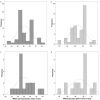Characteristics of the heme catabolic pathway in mild unconjugated hyperbilirubinemia and their associations with inflammation and disease prevention
- PMID: 28389660
- PMCID: PMC5429724
- DOI: 10.1038/s41598-017-00933-y
Characteristics of the heme catabolic pathway in mild unconjugated hyperbilirubinemia and their associations with inflammation and disease prevention
Abstract
Heme catabolism exerts physiological functions that impact health through depressing inflammation. Upon reactive pathway progression, as in Gilbert's Syndrome (GS; UGT1A1*28 polymorphism), aggravated health effects have been determined. Based on lower inflammation and improved metabolic health reported for GS, inter-group differences in heme catabolism were explored. Therefore, a case-control study including 120 fasted, healthy, age- and gender matched subjects with/without GS, was conducted. Genetic expressions of HMOX-1 and BLVRA were measured. Additionally participants were genotyped for those polymorphisms that are known (UGT1A1*28) or likely (HMOX-1 microsatellites) to impact bilirubinemia. Intracellular interleukins (IL-6, IL-1β, TNFα), circulatory C-reactive protein (CRP), serum amyloid A (SAA) and haptoglobin (Hpt) were analysed as inflammatory markers. To assess intracellular heme oxygenase 1 (HO-1) isolated PBMCs were used. In GS vs. C, inflammation markers were significantly decreased. This was supported by an altered heme catabolism, indirectly reflecting in elevated unconjugated bilirubin (UCB; main phenotypic feature of GS) and iron, decreased hemopexin (Hpx) and Hpt and in up-regulated biliverdin reductase (BLVRA) gene expressions. Moreover, HMOX (GT)n short alleles were non-significantly more prominent in female GS individuals. Herewith, we propose a concept to elucidate why GS individuals encounter lower inflammation, and are thus less prone to oxidative-stress mediated diseases.
Conflict of interest statement
The authors declare that they have no competing interests.
Figures




Similar articles
-
Haem catabolism: a novel modulator of inflammation in Gilbert's syndrome.Eur J Clin Invest. 2013 Sep;43(9):912-9. doi: 10.1111/eci.12120. Epub 2013 Jul 19. Eur J Clin Invest. 2013. PMID: 23865893
-
Association of (GT)n repeats promoter polymorphism of heme oxygenase-1 gene with serum bilirubin levels in healthy Indian adults.Genet Test Mol Biomarkers. 2011 Apr;15(4):215-8. doi: 10.1089/gtmb.2010.0132. Epub 2011 Jan 3. Genet Test Mol Biomarkers. 2011. PMID: 21198350
-
Inflammatory response to coronary artery bypass surgery: does the heme-oxygenase-1 gene microsatellite polymorphism play a role?Chin Med J (Engl). 2005 Aug 5;118(15):1285-90. Chin Med J (Engl). 2005. PMID: 16117883
-
Bilirubin, platelet activation and heart disease: a missing link to cardiovascular protection in Gilbert's syndrome?Atherosclerosis. 2015 Mar;239(1):73-84. doi: 10.1016/j.atherosclerosis.2014.12.042. Epub 2014 Dec 24. Atherosclerosis. 2015. PMID: 25576848 Review.
-
Contribution of inflammatory processes to nerve cell toxicity by bilirubin and efficacy of potential therapeutic agents.Curr Pharm Des. 2009;15(25):2915-26. doi: 10.2174/138161209789058165. Curr Pharm Des. 2009. PMID: 19754368 Review.
Cited by
-
TLR4 counteracts BVRA signaling in human leukocytes via differential regulation of AMPK, mTORC1 and mTORC2.Sci Rep. 2019 May 7;9(1):7020. doi: 10.1038/s41598-019-43347-8. Sci Rep. 2019. PMID: 31065010 Free PMC article.
-
Circulating bilirubin levels and risk of colorectal cancer: serological and Mendelian randomization analyses.BMC Med. 2020 Sep 3;18(1):229. doi: 10.1186/s12916-020-01703-w. BMC Med. 2020. PMID: 32878631 Free PMC article.
-
Oxidative Stress and Related Biomarkers in Gilbert's Syndrome: A Secondary Analysis of Two Case-Control Studies.Antioxidants (Basel). 2021 Sep 15;10(9):1474. doi: 10.3390/antiox10091474. Antioxidants (Basel). 2021. PMID: 34573106 Free PMC article.
-
Gilbert's Syndrome and the Gut Microbiota - Insights From the Case-Control BILIHEALTH Study.Front Cell Infect Microbiol. 2021 Sep 16;11:701109. doi: 10.3389/fcimb.2021.701109. eCollection 2021. Front Cell Infect Microbiol. 2021. PMID: 34604105 Free PMC article.
-
Prognostic value of preoperative serum bilirubin levels in ovarian cancer.Am J Transl Res. 2020 May 15;12(5):2267-2280. eCollection 2020. Am J Transl Res. 2020. PMID: 32509218 Free PMC article.
References
-
- Radu P, Atsmon J. Gilbert’s syndrome-clinical and pharmacological imwaplications. Isr. Med. Assoc. J. 2001;3:593–598. - PubMed
Publication types
MeSH terms
Substances
LinkOut - more resources
Full Text Sources
Other Literature Sources
Medical
Research Materials
Miscellaneous

